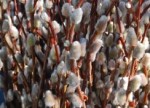 Easter traditions commonly include eggs, rabbits, Easter lilies, palms, jelly beans and other candy. For some people, however, pussy willows can be added to the list. Pussy willows are one of the harbinger’s of spring and so often bloom about the time of Easter. It is little wonder that some cultures have incorporated them into their rituals of Spring.The people of northern Europe use pussy willow for Easter celebrations in a couple of ways. Since they lack the palm leaves needed for Palm Sunday, they use pussy willows instead to construct small and large, attractive standards to carry on that special day. Many other plants, ribbons and decorations are used with the pussy willow to construct the palms. In Poland and the Ukraine the people gently strike each other with the pussy willow palms, a custom known as Boz Rany (God’s Wounds), imitating the scourging of Jesus.
Easter traditions commonly include eggs, rabbits, Easter lilies, palms, jelly beans and other candy. For some people, however, pussy willows can be added to the list. Pussy willows are one of the harbinger’s of spring and so often bloom about the time of Easter. It is little wonder that some cultures have incorporated them into their rituals of Spring.The people of northern Europe use pussy willow for Easter celebrations in a couple of ways. Since they lack the palm leaves needed for Palm Sunday, they use pussy willows instead to construct small and large, attractive standards to carry on that special day. Many other plants, ribbons and decorations are used with the pussy willow to construct the palms. In Poland and the Ukraine the people gently strike each other with the pussy willow palms, a custom known as Boz Rany (God’s Wounds), imitating the scourging of Jesus.
Poles and other Slavic people use pussy willows on Easter Monday as part of Dyngus Day celebrations. Whips are made of pussy willows and other plants with ribbons tied on top. Young men use these soft whips to gently strike the legs of women. The men also sprinkle or douse the women with water and this latter practice is becoming more popular at the expense of the pussy willow whipping. Too bad. The concept of gently whipping women goes back to ancient times when on Lupercalia in mid February women presented themselves for this ritual in hopes of becoming fertile.
 Pussy willows are native to the wetlands Canada and Eastern United States. They are shrubs or small trees and are valued for their fuzzy flowers that resemble the toes of a cat. The fuzzy structures are classified as catkins and are made up of male flowers. As the season goes on, they produce an abundance of yellow stamens with anthers containing pollen that they readily shed. The female flowers are borne on different plants and await the arrival of the pollen from the male flowers as the wind carries it by.
Pussy willows are native to the wetlands Canada and Eastern United States. They are shrubs or small trees and are valued for their fuzzy flowers that resemble the toes of a cat. The fuzzy structures are classified as catkins and are made up of male flowers. As the season goes on, they produce an abundance of yellow stamens with anthers containing pollen that they readily shed. The female flowers are borne on different plants and await the arrival of the pollen from the male flowers as the wind carries it by.